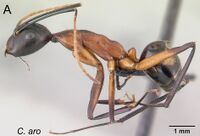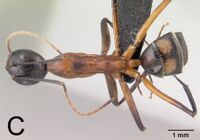Camponotus aro
| Camponotus aro | |
|---|---|

| |
| Scientific classification | |
| Kingdom: | Animalia |
| Phylum: | Arthropoda |
| Class: | Insecta |
| Order: | Hymenoptera |
| Family: | Formicidae |
| Subfamily: | Formicinae |
| Tribe: | Camponotini |
| Genus: | Camponotus |
| Subgenus: | Myrmosaga |
| Species: | C. aro |
| Binomial name | |
| Camponotus aro Rakotonirina & Fisher, 2022 | |
Geographically restricted to the PN Namoroka in the western dry forest of Madagascar, C. aro has been found nesting under stones while workers forage on the ground or through leaf litter and on lower vegetation.
Identification
Rakotonirina and Fisher (2022) - With head in full-face view, lateral margins of head anterior to eye level parallel, lacking erect hairs, lateral cephalic margin rounding to posterior margin, anteromedian clypeal margin continuously forming broad convexity; propodeal dorsum immediately posterior to metanotal groove convex, then concave medially and rounding to declivity surface.
Camponotus aro is morphologically similar to Camponotus gouldi in that both species are characterized by a broadly convex anteromedian margin of clypeus, but the latter species is diagnosed as having a head that extends posteriorly into a broad, short neck and its propodeal dorsum is straight.
Keys including this Species
Distribution
Distribution based on Regional Taxon Lists
Malagasy Region: Madagascar (type locality).
Distribution based on AntMaps
Distribution based on AntWeb specimens
Check data from AntWeb
Countries Occupied
| Number of countries occupied by this species based on AntWiki Regional Taxon Lists. In general, fewer countries occupied indicates a narrower range, while more countries indicates a more widespread species. |

|
Estimated Abundance
| Relative abundance based on number of AntMaps records per species (this species within the purple bar). Fewer records (to the left) indicates a less abundant/encountered species while more records (to the right) indicates more abundant/encountered species. |

|
Biology
Castes
Nomenclature
The following information is derived from Barry Bolton's Online Catalogue of the Ants of the World.
- aro. Camponotus aro Rakotonirina & Fisher, 2022: 42, figs. 25B, 31B, 42 (s.w.) MADAGASCAR.
- Type-material: holotype worker (caste not indicated), 1 paratype major worker, 2 paratype minor workers.
- Type-locality: holotype Madagascar: Mahajanga, PN de Namoroka, 17.8 km. 329° WNW Vilanandro, -16.37667, 45.32667, 100 m., 8.xi.2002, BLF06542 (B.L. Fisher, C.E. Griswold, et al.); paratypes with same data.
- Type-depositories: CASC (holotype); BMNH, CASC, MHNG (paratypes).
- Distribution: Madagascar.
Unless otherwise noted the text for the remainder of this section is reported from the publication that includes the original description.
Description
Worker
Morphological measurements: see Appendix 1 and Morphological measurements: see Appendix 1 and Ratios of morphometric data for majors and minors
Minor In full-face view, head widest at midlength; lateral margins posterior to level of eye, rounding evenly to posterior margin; eye protruding and large (EL/CS: 0.25±0.01; 0.23–0.26), not breaking lateral cephalic margin; level of its posterior border located at ca. posterior 1/3 of head (PoOc/CL: 0.28±0.01; 0.27–0.30); frontal carinae posteriorly parallel (FR/CS: 0.25±0.01; 0.24–0.27); clypeus without anterolateral angle, its anteromedian margin broadly convex; mandible with six teeth, its two apical teeth distantly spaced; antennal scape relatively long (SL/CS: 1.59±0.08; 1.46–1.71). Mesosoma long and low (MPH/ML: 0.28±0.01; 0.26–0.30), promesonotum weakly convex, mesonotum with posterior portion flat immediately anterior to a weakly visible metanotal groove; propodeal dorsum anteriorly convex, with feeble concavity medially, dorsal margin of propodeum rounding to declivity; propodeal dorsum 2 × as long as declivity. Petiolar node nodiform; with dorsal margin inclined posteriorly and forming a blunt angle to anterior face; anterior face of petiolar node 1/2 height of posterior face; femur of hind leg rounded axially and twisted basally.
First and second gastral tergites with a pair of white spots; erect hairs on lateral margin of head absent; two erect hairs present near posterior margin of head; antennal scape only covered with appressed hairs; pronotum with a pair of erect hairs; posterodorsal angle of propodeum with a pair of erect hairs.
Major Differing from minor worker in the following characters: enlarged head (CS: 3.10±0.18; 2.82–3.29; CWb/CL: 0.92±0.01; 0.90–0.94) with markedly concave posterior margin; apical 1/3 of antennal scape extending beyond posterior cephalic margin; robust mesosoma with propodeal dorsum slightly concave and its length ca. 2 × height of declivity; petiole tapering dorsally.
Type Material
- Holotype worker. MADAGASCAR: Province Mahajanga: PN de Namoroka, 17.8 km 329° WNW Vilanandro, -16.37667, 45.32667, 100 m, dry forest, under stone, 08 Nov 2002 (Fisher, Griswold et al.) collection code: BLF06542, specimen code: CASENT0489917 (CAS).
- Paratypes. 2 minor workers and 1 major worker with same data as holotype but with specimen codes: CASENT0837586, CASENT0837587, CASENT0489918 (NHMUK, MHNG, CAS).
Etymology
The species name aro is a non-Latin singular noun used in apposition.

